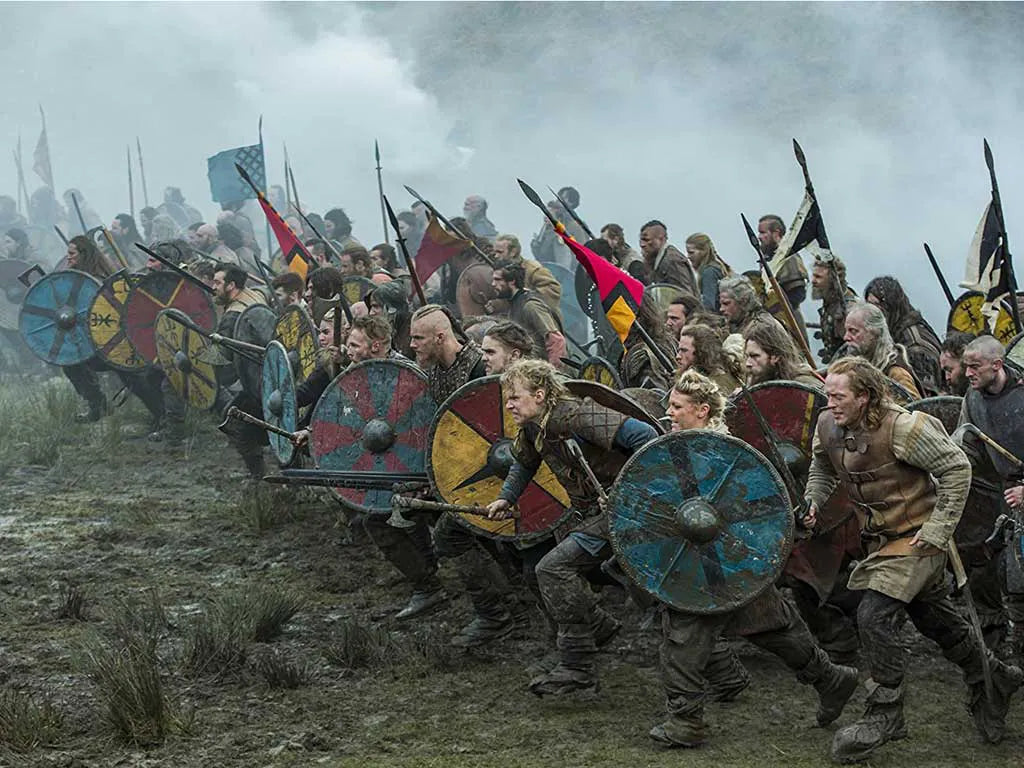The seafaring Norse people are often remembered for their daring raids, exploration and settlement during the Viking Age (c. 793–1066 CE). While their navigation and exploration skills are widely celebrated, their prowess in warfare played a critical role in their success.

The Foundation of Viking Warfare
Viking warfare was deeply rooted in the societal structure of their time. The Norsemen were not a unified force but consisted of various clans and tribes, nor were all Norse peoples Vikings. To go Viking, or víkingr, meant to leave the farm life behind – at least for a while – and embark in an adventure that included traveling, trading and raiding. Viking was an activity, a profession; not an ethnicity.
At the time the Norse peoples lacked a strong centralized authority, which meant that Viking warfare was often opportunistic and decentralized. Raids were a cornerstone of their strategy, primarily driven by the pursuit of wealth, resources, and land. These expeditions were both strategic and symbolic, showcasing the raiders' bravery and earning them a reputation as fierce warriors.
The most commonly depicted tactic used in a Viking battle was the skjaldborg or shield wall, a defensive formation that displayed their discipline and tactical acumen. Warriors stood shoulder to shoulder, their shields overlapping, creating a nearly impenetrable barrier. This tactic was particularly effective during both offensive and defensive engagements, but this must be taken with a grain of salt, as there are some archaeologists who claim that the Vikings did not use the shield wall formation at all, such as Rolf Warming, archaeologist and researcher at the University of Copenhagen.

Viking Weaponry and Armor
The Viking arsenal was diverse and effective, reflecting both their ingenuity and the resources available to them. Common weapons included:
Swords: The Viking sword was a highly valued weapon, often passed down through generations as they were quite expensive. Double-edged and typically around 90 cm long, these swords were designed for slashing and stabbing.
Axes: While swords symbolized status, axes were more widely used due to their affordability and versatility. The Dane axe, a large two-handed weapon, was particularly feared on the battlefield.
Spears: A staple weapon, spears were used for both throwing and thrusting. They were versatile, lightweight, and effective in group formations.
Bows and Arrows: Archery was crucial in Viking warfare, especially during sieges and naval battles. Arrows were often tipped with iron for maximum lethality.
In terms of armor, Vikings typically wore anything they could actually afford, often a combination of chainmail, leather, and padded garments. Helmets were simpler than popular depictions suggest; they were often conical with a nose guard, offering effective protection. Contrary to myth, they did not wear horned helmets in battle.
Naval Superiority
The Vikings' naval capabilities were unparalleled in their era. Their iconic longships were both swift and versatile, enabling them to strike swiftly and retreat before an organized defense could be mounted. These ships, with shallow drafts, allowed them to navigate rivers and coastlines, giving them access to inland territories that other seafaring raiders could not reach. This mobility was a game-changer, allowing Vikings to surprise and overwhelm their enemies.

Cultural Significance of Warfare
Warfare was more than a practical necessity for the Vikings; it was deeply intertwined with the Norse culture and mythology. For the Norse, dying honorably in battle meant entry to Valhalla, Odin's hall, where they would feast and prepare for Ragnarök (the end of the world). This belief inspired incredible bravery, as warriors sought to achieve a heroic death.
Decline of Viking Warfare
The decline of Viking dominance in warfare was gradual, resulting from increased resistance by European kingdoms and the Vikings' integration into the cultures they once raided. By the end of the 11th century, changes in political structures and the Christianization of Scandinavia marked the end of the Viking Age. Despite this, their legacy as formidable warriors endures in both history and popular culture.

Viking warfare was a complex interplay of strategy, culture, and innovation. Their mastery of naval technology, disciplined tactics, and fearsome reputation ensured their success on the battlefield. More than mere raiders, the Vikings were skilled warriors whose influence reshaped the medieval world.
References
Haywood, J. (2016). Northmen: The Viking Saga, AD 793–1241. Thomas Dunne Books. ISBN: 978-1250106145.
Ferguson, R. (2009). The Hammer and the Cross: A New History of the Vikings. Penguin Books. ISBN: 978-0143118015.














